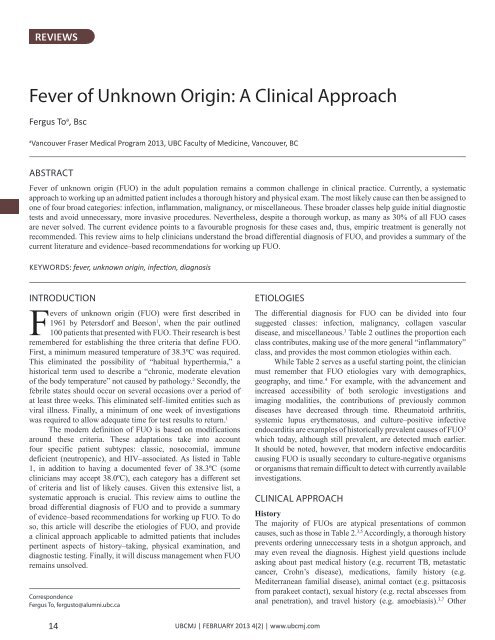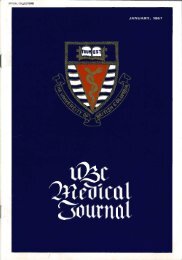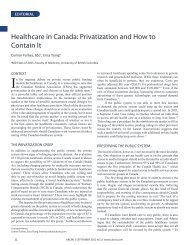Fever of Unknown Origin: A Clinical Approach - UBC Medical Journal
Fever of Unknown Origin: A Clinical Approach - UBC Medical Journal
Fever of Unknown Origin: A Clinical Approach - UBC Medical Journal
Create successful ePaper yourself
Turn your PDF publications into a flip-book with our unique Google optimized e-Paper software.
REVIEWS<br />
<strong>Fever</strong> <strong>of</strong> <strong>Unknown</strong> <strong>Origin</strong>: A <strong>Clinical</strong> <strong>Approach</strong><br />
Fergus To a , Bsc<br />
a<br />
Vancouver Fraser <strong>Medical</strong> Program 2013, <strong>UBC</strong> Faculty <strong>of</strong> Medicine, Vancouver, BC<br />
ABSTRACT<br />
<strong>Fever</strong> <strong>of</strong> unknown origin (FUO) in the adult population remains a common challenge in clinical practice. Currently, a systematic<br />
approach to working up an admitted patient includes a thorough history and physical exam. The most likely cause can then be assigned to<br />
one <strong>of</strong> four broad categories: infection, inflammation, malignancy, or miscellaneous. These broader classes help guide initial diagnostic<br />
tests and avoid unnecessary, more invasive procedures. Nevertheless, despite a thorough workup, as many as 30% <strong>of</strong> all FUO cases<br />
are never solved. The current evidence points to a favourable prognosis for these cases and, thus, empiric treatment is generally not<br />
recommended. This review aims to help clinicians understand the broad differential diagnosis <strong>of</strong> FUO, and provides a summary <strong>of</strong> the<br />
current literature and evidence–based recommendations for working up FUO.<br />
KEYWORDS: fever, unknown origin, infection, diagnosis<br />
INTRODUCTION<br />
<strong>Fever</strong>s <strong>of</strong> unknown origin (FUO) were first described in<br />
1961 by Petersdorf and Beeson 1 , when the pair outlined<br />
100 patients that presented with FUO. Their research is best<br />
remembered for establishing the three criteria that define FUO.<br />
First, a minimum measured temperature <strong>of</strong> 38.3ºC was required.<br />
This eliminated the possibility <strong>of</strong> “habitual hyperthermia,” a<br />
historical term used to describe a “chronic, moderate elevation<br />
<strong>of</strong> the body temperature” not caused by pathology. 2 Secondly, the<br />
febrile states should occur on several occasions over a period <strong>of</strong><br />
at least three weeks. This eliminated self–limited entities such as<br />
viral illness. Finally, a minimum <strong>of</strong> one week <strong>of</strong> investigations<br />
was required to allow adequate time for test results to return. 1<br />
The modern definition <strong>of</strong> FUO is based on modifications<br />
around these criteria. These adaptations take into account<br />
four specific patient subtypes: classic, nosocomial, immune<br />
deficient (neutropenic), and HIV–associated. As listed in Table<br />
1, in addition to having a documented fever <strong>of</strong> 38.3ºC (some<br />
clinicians may accept 38.0ºC), each category has a different set<br />
<strong>of</strong> criteria and list <strong>of</strong> likely causes. Given this extensive list, a<br />
systematic approach is crucial. This review aims to outline the<br />
broad differential diagnosis <strong>of</strong> FUO and to provide a summary<br />
<strong>of</strong> evidence–based recommendations for working up FUO. To do<br />
so, this article will describe the etiologies <strong>of</strong> FUO, and provide<br />
a clinical approach applicable to admitted patients that includes<br />
pertinent aspects <strong>of</strong> history–taking, physical examination, and<br />
diagnostic testing. Finally, it will discuss management when FUO<br />
remains unsolved.<br />
Correspondence<br />
Fergus To, fergusto@alumni.ubc.ca<br />
ETIOLOGIES<br />
The differential diagnosis for FUO can be divided into four<br />
suggested classes: infection, malignancy, collagen vascular<br />
disease, and miscellaneous. 3 Table 2 outlines the proportion each<br />
class contributes, making use <strong>of</strong> the more general “inflammatory”<br />
class, and provides the most common etiologies within each.<br />
While Table 2 serves as a useful starting point, the clinician<br />
must remember that FUO etiologies vary with demographics,<br />
geography, and time. 4 For example, with the advancement and<br />
increased accessibility <strong>of</strong> both serologic investigations and<br />
imaging modalities, the contributions <strong>of</strong> previously common<br />
diseases have decreased through time. Rheumatoid arthritis,<br />
systemic lupus erythematosus, and culture–positive infective<br />
endocarditis are examples <strong>of</strong> historically prevalent causes <strong>of</strong> FUO 3<br />
which today, although still prevalent, are detected much earlier.<br />
It should be noted, however, that modern infective endocarditis<br />
causing FUO is usually secondary to culture-negative organisms<br />
or organisms that remain difficult to detect with currently available<br />
investigations.<br />
CLINICAL APPROACH<br />
History<br />
The majority <strong>of</strong> FUOs are atypical presentations <strong>of</strong> common<br />
causes, such as those in Table 2. 3,5 Accordingly, a thorough history<br />
prevents ordering unneccessary tests in a shotgun approach, and<br />
may even reveal the diagnosis. Highest yield questions include<br />
asking about past medical history (e.g. recurrent TB, metastatic<br />
cancer, Crohn’s disease), medications, family history (e.g.<br />
Mediterranean familial disease), animal contact (e.g. psittacosis<br />
from parakeet contact), sexual history (e.g. rectal abscesses from<br />
anal penetration), and travel history (e.g. amoebiasis). 3,7 Other<br />
14<br />
<strong>UBC</strong>MJ | FEBRUARY 2013 4(2) | www.ubcmj.com
REVIEWS<br />
social practices including drug use, unusual diet (e.g. unpasteurised<br />
products), and environmental exposures may also be helpful. 7 Less<br />
helpful in history is the magnitude <strong>of</strong> the temperature readings,<br />
the patterns <strong>of</strong> fever, and response to antipyretics. These areas are<br />
not specific enough for diagnosis according to a study that looked<br />
at 346 FUO patients admitted to the National Institute <strong>of</strong> Health. 7<br />
A thorough history as described above helps the clinician<br />
decide whether the FUO etiology is due to infection, inflammation,<br />
malignancy, or sources that fall into the miscellaneous category. 8<br />
Through the course <strong>of</strong> diagnostic work-up, repeat history should<br />
be taken to ensure no potential clues are missed. 5<br />
Physical Exam<br />
An adequate physical exam is one that looks at every system<br />
for subtle clues, including full neurological, head and neck,<br />
musculoskeletal, dermatological, and fundoscopic exams.<br />
Changes in mental status, for example, may point to granulomatous<br />
meningitis. A thorough head and neck exam should assess the<br />
thyroid, oral cavity, temporal artery, and lymph nodes; this will<br />
help to rule out thyroiditis, dental abscesses, temporal arteritis, and<br />
lymphoma or tuberculosis, respectively. 3 New cardiac murmurs<br />
may point to infective endocarditis, and on dermatological exam,<br />
stigmata <strong>of</strong> infective endocarditis should be ruled out. Increased<br />
pigmentation should also be noted as it could indicate a late<br />
presentation <strong>of</strong> Whipple’s disease, which is less commonly seen<br />
in modern practice due to earlier detection. 3<br />
As fever can result from virtually any pathology in any <strong>of</strong><br />
the body’s systems, a full physical exam is always warranted.<br />
Abnormalities should be noted as they may suggest a diagnosis<br />
that would otherwise be missed. Two studies have shown that<br />
up to 60% <strong>of</strong> abnormalities on physical exam have helped guide<br />
diagnosis. 3,8,13 Repeat exams should be conducted daily to ensure<br />
new findings are noted.<br />
Investigations<br />
If clues from the history and physical exam point to a likely<br />
diagnosis, initial investigations should be tailored around them.<br />
For example, if an infectious cause is high on the clinician’s<br />
differential, tests such as AFB cultures, smears for malaria, or<br />
serology for VDRL, HIV, CMV, EBV, and ASO are useful starting<br />
points. 13 Investigations for malignancy may include peripheral<br />
smears, serum protein electrophoresis, endoscopies, and bone<br />
scans. 13 Autoimmune connective tissue diseases should trigger<br />
orders for antinuclear antibodies and rheumatoid factor. 13 By<br />
choosing the appropriate initial tests, a diagnosis can be reached<br />
in up to a quarter <strong>of</strong> FUO. 3<br />
When faced with a history and physical exam that are not<br />
helpful, the clinician should start with a basic set <strong>of</strong> tests to<br />
guide further workup. No uniform set <strong>of</strong> investigations has been<br />
established, but an appropriate group <strong>of</strong> tests should include<br />
complete blood count, electrolytes, liver enzymes and function<br />
tests, urinalysis, three blood cultures, rheumatologic markers<br />
(ANA, ANCA, RF), HIV antibody, tuberculin skin test and a chest<br />
x-ray. 3,7<br />
Further imaging with computer tomography (CT) <strong>of</strong> the<br />
abdomen should only be done if initial assessments are suggestive<br />
Table 1. Categories <strong>of</strong> <strong>Fever</strong>s <strong>of</strong> <strong>Unknown</strong> <strong>Origin</strong>. All FUOs require a measured<br />
fever <strong>of</strong> at least 38.3ºC. 5,6<br />
Classic<br />
Category Criteria Common Causes<br />
Nosocomial<br />
Immune deficient<br />
(neutropenic)<br />
HIV-associated<br />
• Duration <strong>of</strong> at least 3 weeks<br />
• Evaluation <strong>of</strong> at least 3<br />
outpatient appointments or 3<br />
days in hospital<br />
• Hospitalized at least 24 hours<br />
• Did not have a fever and<br />
was not incubating one on<br />
admission<br />
• Evaluation <strong>of</strong> at least 3 days<br />
• Neutropenia (ANC < 500/<br />
mm 3 )<br />
• Evaluation <strong>of</strong> at least 3<br />
days in<br />
• Duration <strong>of</strong> at least 4 weeks<br />
as outpatient or 3 days as<br />
inpatient<br />
• Confirmed HIV<br />
Table 2. Common causes <strong>of</strong> FUO 5,6,11,12<br />
Infection, malignancy,<br />
collagen vascular<br />
disease<br />
Clostridium difficile<br />
enterocolitis, druginduced,<br />
pulmonary<br />
embolism, septic<br />
thrombophlebitis,<br />
sinusitis<br />
Opportunistic bacterial<br />
infections and fungal<br />
infections, herpes virus<br />
Cytomegalovirus,<br />
Mycobacterium<br />
avium-intracellulare<br />
complex, Pneumocystis<br />
carinii pneumonia,<br />
drug-induced, Kaposi’s<br />
sarcoma, lymphoma<br />
Class Contribution Most Common Diseases<br />
Infection 28% Tuberculosis (especially extra-pulmonary)<br />
Abscesses (intra-abdominal, pelvic, dental,<br />
renal, perinephric)<br />
Endocarditis<br />
Osteomyelitis<br />
Epstein-Barr virus mononucleosis<br />
Cytomegalovirus<br />
Cat scratch disease<br />
Lyme disease<br />
Prostatitis<br />
Inflammatory 21% Adult Still’s disease (adult juvenile<br />
rheumatoid arthritis)<br />
Polymyalgia rheumatica<br />
Temporal arteritis<br />
Rheumatoid arthritis (especially late onset)<br />
Systemic lupus erythematosus<br />
Inflammatory bowel disease<br />
Malignancy 17% Leukemia and lymphoma<br />
Metastatic cancers<br />
Renal cell carcinoma<br />
Colon carcinoma<br />
Hepatoma<br />
Myelodysplastic syndromes<br />
Pancreatic carcinoma<br />
Sarcomas<br />
Miscellaneous 15% Drug-induced fever<br />
Complications from cirrhosis<br />
Factitious fever<br />
Hepatitis (alcoholic, granulomatous, or<br />
lupoid)<br />
Deep venous thrombosis<br />
Sarcoidosis<br />
Mediterranean familial fever<br />
Hyperthyroidism<br />
No diagnosis at<br />
time <strong>of</strong> discharge<br />
19%<br />
<strong>UBC</strong>MJ | FEBRUARY 2013 4(2) | www.ubcmj.com<br />
15
REVIEWS<br />
<strong>of</strong> an abdominal cause or if the tests are not helpful in guiding<br />
further workup. This is because many CT abdomen scans do<br />
not lead to an actual diagnosis even when a lesion is noted. 3 In<br />
a prospective analysis, abnormalities on CT demonstrated more<br />
false positives than true positives – 28% and 20%, respectively. 6<br />
Jumping to CT without just cause leads to unnecessary workup,<br />
needless radiation exposure, and opens doors to further invasive<br />
procedures such as laparatomies and biopsies. 3<br />
Further investigations, including imaging, biopsies, and<br />
serology, should be guided by reassessment <strong>of</strong> history, physical<br />
exam, and initial investigative results. As in the case <strong>of</strong> the CT<br />
abdomen, the clinician must consider the diagnostic yield <strong>of</strong> each<br />
test as well as its potential for false results.<br />
7. Aduan RP, Fauci AS, Dale DC, Wolff SM. Prolonged fever <strong>of</strong><br />
unknown origin (FUO): a prospective study <strong>of</strong> 347 patients. Clin Res<br />
1978;26:558A.<br />
8. Pizzo PA, Lovejoy FH, Smith DH. Prolonged fever in children: review<br />
<strong>of</strong> 100 cases. Pediatrics 1975;55:468–73.<br />
9. Fenollar F, Puéchal X, Raoult D. Whipple’s disease. N Engl J Med<br />
2007;356:55-66.<br />
10. Lohr JA, Hendley JO. Prolonged fever <strong>of</strong> unknown origin; a record <strong>of</strong><br />
experiences with 54 childhood patients. Clin Pediatr 1977;16:768–73.<br />
11. Varghese G, Trowbridge P, Doherty T. Investigating and managing<br />
pyrexia <strong>of</strong> unknown origin in adults. BMJ 2010;341:c5470.<br />
12. Roth AR, Basello GM. <strong>Approach</strong> to the adult patient with fever <strong>of</strong><br />
unknown origin. Am Fam Physician 2003 Dec 1;68(11):2223-8.<br />
13. Bryan, CS and Ahuja D. <strong>Fever</strong> <strong>of</strong> unknown origin: Is there a role for<br />
empiric therapy Infect Dis Clin North Am 2007 Dec;21(4):1213-20, xi.<br />
When FUO remains unsolved<br />
Despite a diligent workup <strong>of</strong> FUO, as many as 30% <strong>of</strong> cases remain<br />
unsolved at time <strong>of</strong> discharge. 13 Clinicians are then faced with<br />
the question <strong>of</strong> whether empiric treatment is necessary. In a study<br />
looking at 199 cases <strong>of</strong> FUO, 61 patients (30%) were discharged<br />
without a causal diagnosis. Thirty-one <strong>of</strong> these unsolved cases had<br />
defervesced by the time <strong>of</strong> discharge. At 5–year follow-up, only 2<br />
<strong>of</strong> the 61 patients had died secondary to the FUO, 13 pointing to the<br />
generally favourable prognosis <strong>of</strong> untreated FUO.<br />
For this reason, there is little role for empiric treatment<br />
<strong>of</strong> FUO. Current literature supports empiric treatment in only<br />
three specific situations: cases suggestive <strong>of</strong> culture–negative<br />
endocarditis, cryptic disseminated tuberculosis, and temporal<br />
arteritis that jeopardizes vision. 13<br />
SUMMARY<br />
FUO remains a common challenge in clinical practice. A<br />
systematic approach to working up a patient includes a thorough<br />
history and physical exam. The most likely cause can then be<br />
assigned to one <strong>of</strong> four broad categories: infection, inflammation,<br />
malignancy, or miscellaneous. These broader classes help guide<br />
initial diagnostic tests and avoid unnecessary, more invasive<br />
procedures. Nevertheless, despite a thorough workup, as many<br />
as 30% <strong>of</strong> all FUO cases are never solved. The current evidence<br />
points to a favourable prognosis for these cases and, thus, empiric<br />
treatment is generally not recommended.<br />
REFERENCES<br />
1. Petersdorf R, Beeson P. <strong>Fever</strong> <strong>of</strong> unexplained origin: report on 100<br />
cases. Medicine 1961;40:1-30.<br />
2. Finkelstein H. Habitual hyperthermia during recovery from scarlet<br />
fever. JAMA 1924;83(8):611-612.<br />
3. Arnow P, Flaherty J. <strong>Fever</strong> <strong>of</strong> unknown origin. Lancet.<br />
1997;350(9077):575-80.<br />
4. Cunha B. <strong>Fever</strong> <strong>of</strong> unknown origin: focused diagnostic approach based<br />
on clinical clues from the history, physical examination, and laboratory<br />
tests. Infect Dis Clin North Am. 2007 Dec;21(4):1137-87, xi.<br />
5. Mourad O, Palda V, Detsky A. A comprehensive evidence-based<br />
approach to fever <strong>of</strong> unknown origin. Arch Intern Med 2003;163:545.<br />
6. Bleeker-Rover CP, Vos FJ, de Kleijn EM, Mudde AH, D<strong>of</strong>ferh<strong>of</strong> TS,<br />
Richter C, et al. A prospective multicenter study on fever <strong>of</strong> unknown<br />
origin: the yield <strong>of</strong> a structured diagnostic protocol. Medicine<br />
2007;86:26-38.<br />
16<br />
<strong>UBC</strong>MJ | FEBRUARY 2013 4(2) | www.ubcmj.com










